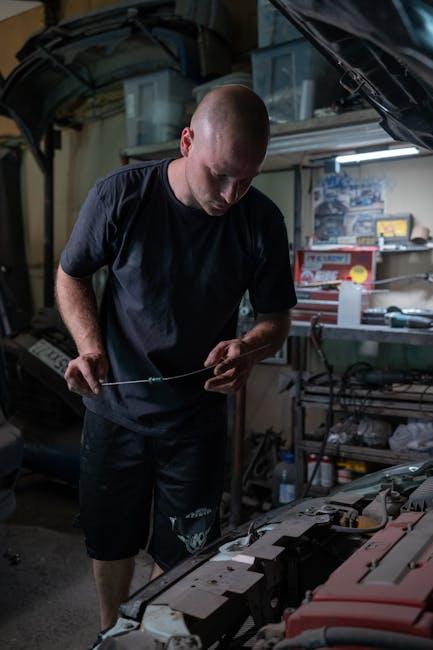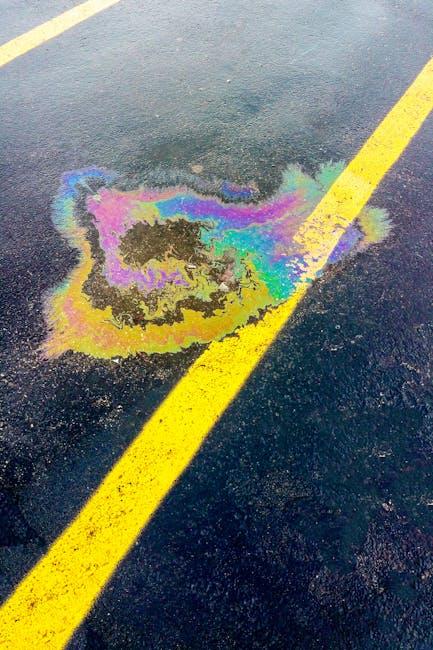There’s a certain art to spotting oil leaks—subtle signs that whisper tales of wear and tear beneath the hood. Whether you’re a seasoned mechanic or a cautious driver, recognizing these early hints can save you a lot of trouble down the road. From glistening puddles beneath your car to faint, pungent odors, oil leaks rarely announce themselves loudly, but their presence is unmistakable once you know what to look for. In this guide, we’ll navigate the clues and common hideouts of escaping oil, helping you catch the problem before it becomes a costly headache.
Table of Contents
- Understanding Common Causes of Oil Leaks
- Identifying Early Warning Signs Beneath Your Vehicle
- Key Areas to Inspect for Hidden Oil Seepage
- Choosing the Right Tools for Leak Detection
- Preventative Tips to Avoid Future Oil Leaks
- When to Seek Professional Assistance for Repairs
- Q&A
- In Summary

Understanding Common Causes of Oil Leaks
Oil leaks often begin quietly but can escalate quickly if not addressed. One of the most common culprits is worn-out or damaged gaskets and seals. These small, flexible components are crucial for maintaining a proper seal between engine parts, but over time, heat and pressure can cause them to crack or degrade. Another frequent cause is loose or over-tightened oil drain plugs and oil filters, which can allow oil to seep out unnoticed during routine maintenance. Additionally, cracks in the oil pan or engine block from road debris or accidents can lead to persistent drips underneath your vehicle.
Recognizing the signs of oil leaks also involves understanding where they tend to occur most often. Keep an eye on areas like:
- Valve cover gasket: Located at the top of the engine, leaks here often leave oil stains on the engine block or underneath the car.
- Oil pan gasket: Positioned at the bottom of the engine, a leak can result in noticeable puddles on the ground.
- Oil filter and drain plug: Improper installation or wear can cause slow drips or even sudden leaks after an oil change.
| Cause | Common Signs | Recommended Action |
|---|---|---|
| Worn Gasket | Engine oil residue on engine | Replace gasket promptly |
| Loose Oil Drain Plug | Fresh oil spots beneath car | Tighten to manufacturer’s spec |
| Cracked Oil Pan | Large oil puddles, engine noise | Inspect and repair or replace |

Identifying Early Warning Signs Beneath Your Vehicle
One of the first clues to a hidden issue is an unexpected trail of fluid on your driveway or garage floor. Keep an eye out for dark, oily spots that glisten when sunlight hits them just right. These stains often reveal the presence of leaking engine oil or transmission fluid—both critical to vehicle health. Additionally, inspect the underside of your car, especially the area around the engine and oil pan, for any wet or grimy patches. These visual hints can signal a slow drip or a more severe leak that needs prompt attention.
To help you differentiate, here’s a quick reference of common early warning signs you might notice beneath your vehicle:
| Sign | Possible Cause | What to Watch For |
|---|---|---|
| Fresh, shiny puddle | Active oil leak | Sharp, dark color; slick texture |
| Sticky residue on parts | Slow seepage over time | Dirt accumulation clinging to oily spots |
| Burnt smell near the floor | Oil contacting hot surfaces | Distinctively acrid odor |
| Low oil levels | Undetected leak | Warning light or dipstick check |
- Check regularly: Consistent monitoring can catch leaks before damage occurs.
- Use a flashlight: It brightens hard-to-see areas beneath your vehicle.
- Note color and location: Different fluids have unique colors and leak points.

Key Areas to Inspect for Hidden Oil Seepage
When examining your vehicle for elusive oil leaks, focus on areas where oil naturally pools or travels. Engine gaskets and seals are common culprits, especially around the valve cover, oil pan, and timing cover. Pay close attention to the undersides of these components, as oils often seep and collect in hidden or hard-to-see spots. Additionally, inspect the oil filter and drain plug for looseness or seepage, as these are frequent sources of minor leaks that can lead to major problems over time.
Another critical area is the engine block itself—look for dark, wet patches that contrast with the metal’s natural finish. Don’t forget the surrounding hoses and oil lines, where cracks or deterioration can allow oil to escape silently. Below is a quick guide to the hotspots with typical signs to watch for:
| Location | Common Signs |
|---|---|
| Valve Cover Gasket | Dark edges, wet streaks, burnt oil smell |
| Oil Pan | Fresh oil droplets, shiny patches under car |
| Oil Filter | Sticky residue, loose fitting |
| Drain Plug | Oil spots on ground, residue around plug |
| Hoses & Lines | Cracks, wetness, brittle texture |

Choosing the Right Tools for Leak Detection
When it comes to identifying oil leaks, having the appropriate equipment can transform a tedious task into a swift and precise operation. Opt for digital inspection tools like infrared cameras or ultrasonic detectors, which can unveil hidden leaks without dismantling components. Handheld dye kits, enhanced with UV lights, are particularly effective in illuminating even the smallest oil traces. Consider versatility, sensitivity, and ease of use as key factors when selecting your toolkit to ensure you’re well-prepared for various leak scenarios.
In addition to selecting the right device, understanding the specific application environment is crucial. For instance, a sensor designed for static systems might underperform in high-pressure hydraulic lines. Below is a quick comparison table to guide your choice based on common leak detection tools:
| Tool | Best For | Key Feature | Limitations |
|---|---|---|---|
| Infrared Camera | Hot surfaces & hidden leaks | Non-invasive thermal imaging | Expensive, requires training |
| Ultrasonic Detector | Pressurized leaks | High-frequency sound detection | Less effective in noisy environments |
| Dye Kits with UV Light | Visual leak identification | Fluorescent tracing | Surface cleaning needed prior use |
- Consider the leak’s nature: slow seep vs. fast drip
- Match tool sensitivity: subtle traces require sensitive detectors
- Ease of access: portable tools benefit confined spaces

Preventative Tips to Avoid Future Oil Leaks
Routine maintenance is your first line of defense against unwanted oil leaks. Regularly checking and changing your vehicle’s oil, along with its filter, keeps the engine lubricated and helps identify potential problems early. Always use the oil type and grade specified by your manufacturer to maintain optimal viscosity and prevent damage to seals and gaskets. Moreover, keep an eye on driveway and garage floors for fresh stains, as early spotting can save costly repairs down the road.
Implementing a few daily habits can significantly reduce the risk of leaks:
- Inspect engine seals and gaskets: Look for signs of wear, cracking, or brittleness.
- Check oil levels frequently: Low oil can be a sign of a leak or burning oil.
- Warm up your engine properly: Avoid cold starts that stress seals and increase leak chances.
- Park on clean surfaces: Spot oil drips early to catch leaks before they worsen.
- Address engine overheating: High temperatures degrade oil seals and cause leaks.
| Preventive Action | Benefit |
|---|---|
| Oil Change | Keeps engine clean and reduces wear |
| Seal Inspection | Detects early signs of deterioration |
| Proper Warm-up | Maintains seal flexibility and integrity |
| Parking Spot Check | Identifies leaks before damage worsens |

When to Seek Professional Assistance for Repairs
When you encounter oil leaks that are persistent, heavy, or spreading rapidly, it’s a clear indicator that professional expertise is needed. Certain symptoms—such as a burning oil smell, visible smoke, or oil pooling under the vehicle after short periods—go beyond simple home fixes. Attempting to patch these issues without proper knowledge can lead to further engine damage or safety hazards. Additionally, if the source of the leak isn’t obvious or lies deep within engine components, specialized diagnostic tools and experience become indispensable.
Here are some red flags that suggest it’s time to consult a mechanic:
- Unusual engine noises: Knocking or ticking sounds linked to low oil levels.
- Warning lights: Oil pressure or check engine lights illuminating on your dashboard.
- Rapid oil consumption: Frequent need to top up engine oil.
- Complex leak locations: Leaks near the timing chain cover or oil pan gaskets.
- Visible damage: Cracked hoses or corroded seals around the engine bay.
| Symptom | Possible Cause | Repair Complexity |
|---|---|---|
| Oil dripping from the oil pan | Damaged oil pan gasket | Moderate |
| Oil pooling around valve cover | Worn valve cover seal | Moderate |
| Smoke from exhaust | Internal oil leak (piston rings) | High |
| Persistent oil smell inside cabin | Leaking turbocharger seals | High |
Q&A
Q&A: How to Spot Oil Leaks
Q1: Why is it important to spot oil leaks early?
A1: Catching oil leaks early can save you money, protect your engine, and prevent environmental damage. A small drip today can become a major repair tomorrow if left unchecked.
Q2: What are the common signs of an oil leak?
A2: Look for puddles or stains under your vehicle, a burning oil smell, smoke coming from the engine, or a sudden drop in oil levels on your dipstick. Also, check for dirty or greasy spots on engine parts.
Q3: Where do oil leaks usually occur?
A3: Common leak points include the valve cover gasket, oil pan gasket, drain plug, oil filter, and front or rear crankshaft seals. These areas endure high pressure and heat, making them prone to leaks.
Q4: How can you visually inspect for leaks?
A4: Start by cleaning the engine surface, then check under the car and around seals for fresh, wet oil. Use a flashlight for a thorough inspection. Sometimes adding a UV dye to the oil can help locate hidden leaks with a special light.
Q5: Is it safe to drive if you notice an oil leak?
A5: It depends on the leak size. A slow drip might be manageable short-term, but if you see a significant puddle or your oil warning light comes on, it’s best to stop driving and address the issue immediately.
Q6: Can regular maintenance help prevent oil leaks?
A6: Absolutely. Regularly changing oil, replacing gaskets and seals as they wear out, and checking the oil level can reduce the risk of leaks and keep your engine running smoothly.
Q7: When should I seek professional help?
A7: If you can’t identify the leak source, notice worsening leaks, or experience engine performance issues, a professional mechanic can diagnose and repair the problem safely and effectively.
In Summary
In the world of vehicle maintenance, spotting an oil leak early can save you from a cascade of costly repairs and unexpected breakdowns. By tuning your eyes to the telltale signs—those subtle stains, the faint but persistent odor, or the unexpected dip in oil levels—you empower yourself to act before a small drip turns into a major problem. Remember, your car speaks in clues; it’s up to you to listen carefully. With a keen eye and a bit of know-how, you’ll keep your engine running smoothly and your journey worry-free. So next time you open the hood, take a moment to look beyond the surface—sometimes, the smallest leak can tell the biggest story.

